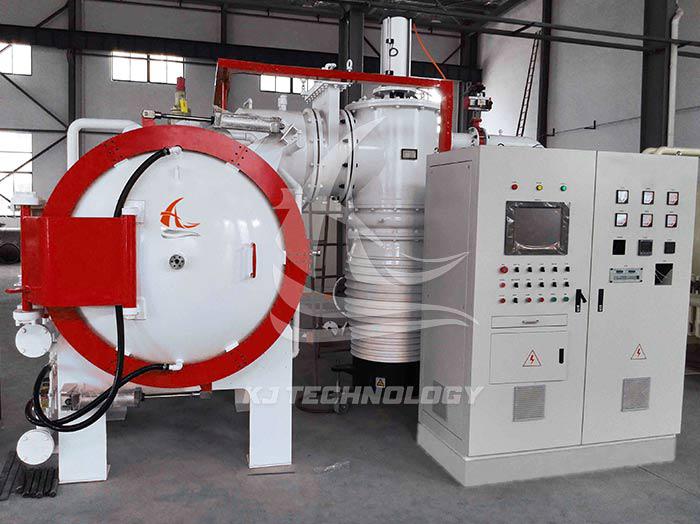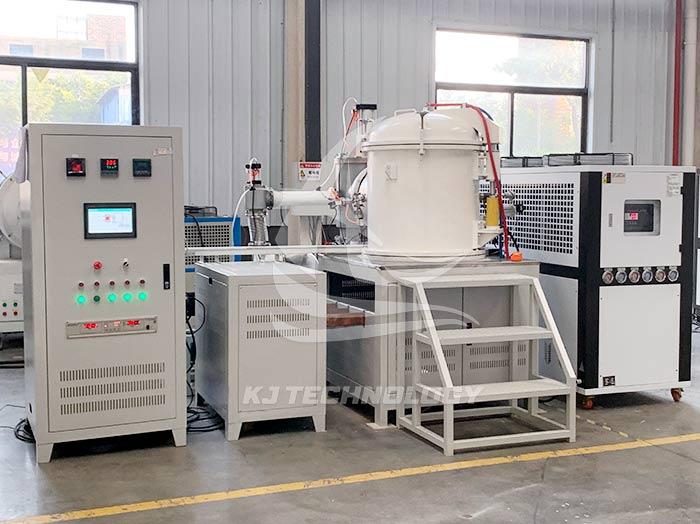Vacuum gas quenching furnace for quenching metal gears
 11-10-2025 Author: KJ technology
11-10-2025 Author: KJ technology
Analysis and recommendation of quenching metal gears in vacuum gas quenching furnace
1. Core advantage: Improve gear performance and production efficiency
Non oxidizing quenching, excellent surface quality
The vacuum gas quenching furnace heats up in a vacuum environment, completely eliminating impurities such as oxygen and water vapor, and avoiding surface oxidation and decarburization of gears. After processing, the surface of the gear is bright and clean, without the need for subsequent polishing, directly meeting the requirements of high-precision assembly. For example, after vacuum quenching, the surface roughness of a certain car transmission gear decreased to below Ra0.4 μ m, significantly improving the meshing smoothness.
Uniform cooling, precise deformation control
By circulating high-pressure gas (such as nitrogen) for cooling, combined with the "low-pressure start+gradual pressure rise" strategy, the cooling rate of each part of the gear is consistent, and the deformation is only one-third of that of traditional salt bath quenching. For example, after a new energy gear was quenched with 20 bar nitrogen gas, the tooth profile distortion decreased from 13 μ m to 4 μ m, meeting the functional safety certification requirements of ISO 26262.
Process flexibility, adaptable to complex requirements
Material compatibility: Supports carbon steel, alloy steel, stainless steel, high-speed steel, etc. Customized quenching can be achieved by adjusting the gas type (nitrogen/argon/helium), pressure (0.5-20 bar), and flow rate. For example, titanium alloy gears are quenched with helium gas at a cooling rate of 100 ℃/s to avoid the risk of nitriding.
Integrated carburizing: Combined with low-pressure vacuum carburizing technology, the depth of the carburizing layer is controllable (0.38-1.8mm), and the uniformity error is ≤± 5%. A certain new energy gear has improved its fatigue life by optimizing carburizing parameters.
2. Key process parameters and case studies
Typical process flow
Preheating: Keep at 650 ℃ for 1.5 hours to eliminate thermal stress.
Carburizing: High temperature carburizing at 960-1050 ℃, combined with pulsed acetylene gas supply (frequency 1-10Hz), with a depth of 1.2-1.8mm in the carburizing layer.
Quenching: stepwise cooling (6 bar slow cooling+18 bar fast cooling), pressure 10-20 bar, choose helium or ≥ 99.999% nitrogen.
Tempering: Tempering at 170-190 ℃ to eliminate quenching stress and improve toughness.
practical case
Case 1: Improving the service life of new energy gears
Material: 17NiCrMo6-4 alloy steel
Process: 960 ℃ carburizing+20bar nitrogen graded quenching
Case 2: Deformation Control of Large Molds
Material: H13 steel (5-ton die-casting mold)
Process: 1.5MPa nitrogen quenching
Result: Deformation ≤ 0.02mm, reduced compared to oil quenching, with higher surface hardness.
3. Equipment selection suggestions
Furnace type selection
Single chamber furnace: suitable for small batch and multi variety production, with low cost but slow cooling speed.
Double chamber furnace (such as Ipsen RVTC type): The heating chamber and gas quenching chamber are separated, which improves production efficiency and is suitable for medium batch production.
Multi chamber continuous furnace (such as ALD VMKZQ type): integrates loading, carburizing, diffusion, and gas quenching modules, improves production efficiency, and is suitable for large-scale automated production.
Gas system configuration
Nitrogen: The preferred choice for economy, with a cost only 1/5 of argon. Nitrogen is used in 85% -95% of gas quenching chambers, and the pressure is usually 2MPa.
Helium: The cooling rate is 30-50% higher than nitrogen, suitable for ultra high speed quenching (such as 100 ℃/s), but the cost is relatively high.
Mixed gas: nitrogen+argon (ratio 7:3), balancing cost and performance, suitable for materials sensitive to nitridation.
Intelligent control
Prioritize equipment equipped with AI simulation optimization system, adjust gas flow rate and diffusion time in real-time through 200000 sets of historical data, control the uniformity error of the infiltration layer within a certain range, and reduce the scrap rate.
4. Recommended application scenarios
New energy vehicle gears
Requirements: High fatigue life, low noise, lightweight.
Recommended process: Vacuum carburizing (960-1050 ℃)+20 bar nitrogen graded quenching+170-190 ℃ tempering.
Effect: Contact fatigue life is increased by 40%, residual compressive stress on the tooth surface is -500 to -800 MPa, and noise is reduced.
Aerospace gears
Requirements: High temperature resistance, corrosion resistance, and high reliability.
Recommended process: high vacuum environment (≤ 10 ⁻ ³ Pa)+helium quenching (100 ℃/s)+deep carburizing (1.5-1.8mm).
Effect: The hardness of the infiltration layer increases, and the strength of the core is improved, meeting the standards.
Precision mold gear
Requirement: Low deformation, high surface quality.
Recommended process: Low pressure start-up (0.5MPa)+gradual pressure increase (to 10MPa)+mixed gas quenching.
Effect: Less deformation, surface roughness Ra0.2 μ m, no need for subsequent precision machining.








